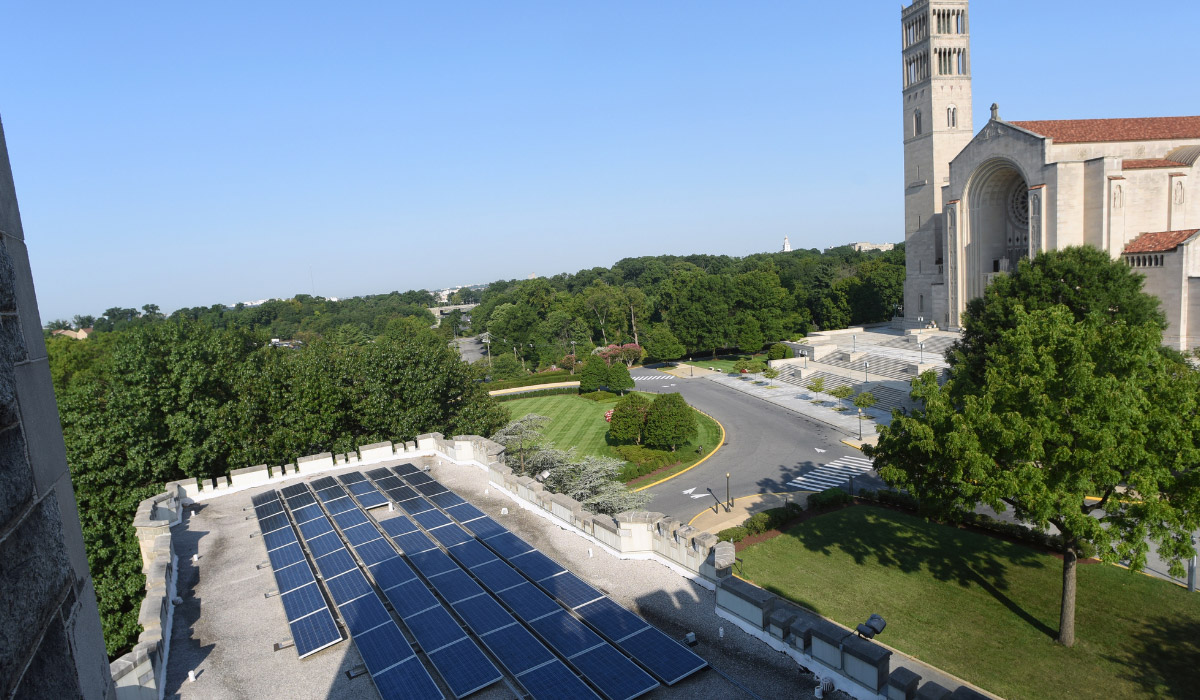

Catholic University became one of the first universities in the world to sign onto a new Vatican initiative, the Laudato Si’ Action Platform, committing to a plan for environmental sustainability.
Inspired by Pope Francis’s 2015 encyclical, Laudato Si’, the initiative was launched by the Dicastery for Integral Human Development this year to engage the universal Catholic Church in “a journey toward full sustainability,” that recognizes our responsibility to care for creation and the disproportionate harm environmental damage has on the vulnerable.
Catholic University already has been recognized as an environmental leader, most recently landing for a second year on the Princeton Review’s Guide to Green Colleges.
Laudato Si’ was important in spurring the University to accelerate its sustainability efforts.
As University President John Garvey noted in 2016, “We are taking to heart Pope Francis’s call for an ‘ecological conversion.’ Our faculty and students are studying that message in the classroom. And they are putting it into effect on our campus in our city and around the world.”
The implementation of sustainable practices on campus has contributed to a decline of carbon emissions by 28% since 2016. Every kilowatt of electricity is paid for with renewable energy credits.
In 2020, the University adopted a five-year-plan for creating a culture of sustainability. The University’s goals range from promoting Catholic social teaching on the environment, to instilling environmental best practices in future architects, engineers, and chemists, to ensuring that the University’s own energy use is clean and sustainable, to helping students and staff care for the earth.
“Showing leadership at the national level in the Church and in society is a core priority, whether that is in academics or student life or sustainability,” said Alexandra Harry Nappier, assistant director for campus facilities and sustainability initiatives. “Having a stronger response to Laudato Si’ is part of the University’s most recent strategic plan. There are a lot of actions and priorities involved in delivering a stronger message and achieving a more coordinated approach.”
The University now offers more than 150 courses related to sustainability across multiple programs, internships in sustainability, and special initiatives such as the planned April 2022 conference, Climate Change and the Future of Work.
Sustainability Initiatives Fuel the Campus
Four campus buildings are LEED-certified, meeting extremely high standards for efficiency. The University is seeking LEED Gold for the new Conway School of Nursing, as well as silver certification as a WELL building, which means it will be built to enhance physical, emotional, and mental health.
Achieving WELL would make this “the first university on the east coast to receive that certification,” Nappier said.
Ten years ago, the University created LEED Lab, an academic course since adopted at schools across the country. Architecture students learn to evaluate buildings for LEED certification. The Crough Center became the first architecture school in the nation to be LEED-certified by its own students.
One of the University’s most important environmental investments was an overhaul of the 1910 power plant and replacement of obsolete steam boilers. The new system, which includes a 15,000-gallon rainwater-harvesting cistern and filtration system, is projected to save 270,226 gallons of water annually and, each year, equivalent emissions from burning over 476 million pounds of coal.
More than 80 stormwater management devices prevent flooding and keep polluted stormwater out of District waterways. Among them are permeable pavement and a “stormceptor” that separates oil and grit from water to protect waterways from pollutants in stormwash.
Construction waste is diverted from the landfill and 100% of the fryer oil from dining facilities is recycled.
The University has drafted a “net zero” energy plan; 100% of its energy usage is offset by purchasing renewable energy credits. These tradable commodities represent proof that one megawatt-hour of electricity was generated from a renewable energy source.
Currently 2,600 solar panels are installed on campus, many unseen on building roofs. A new ground solar array is in the planning stages.
Sustainability in the Classroom
John Judge, dean of the School of Engineering and associate professor of mechanical engineering, encourages students to apply their professional skills to caring for the environment and for the world’s poorest people.
The upcoming conference on climate change will draw on professors from fields as diverse as theology, social work, and the sciences.
“Climate change is going to generate jobs in particular fields that are directly related to the environment – building wind turbines, or electric cars,” said Judge, who is a lead organizer for the event. “But all sorts of jobs will be impacted in less obvious ways. A job that might have nothing to do with the environment will be affected because the supply chain is impacted by the environment, or the price of raw materials shifts.”
“We want to give students an idea of how climate change will affect their careers, no matter what career they choose,” he said.